Choosing the right kitchen flooring is crucial for both the functionality and aesthetic appeal of your space. Kitchen floors experience heavy traffic, spills, and moisture, making it essential to select a material that is durable, easy to maintain, and complements the overall design. With so many options available, such as hardwood, tile, vinyl, and more, it can be overwhelming to make the right choice.
In this guide, we will explore various kitchen flooring ideas, comparing their benefits and drawbacks. Whether you’re looking for something budget-friendly, stylish, or low-maintenance, we’ll help you find the perfect flooring solution for your kitchen.
1. Hardwood Flooring
Hardwood flooring is a popular option for kitchens because of its timeless appeal and natural beauty. Made from solid wood, it offers a warm, inviting look that complements various kitchen styles. Whether you prefer oak, maple, or walnut, hardwood brings an elegant touch to your space.
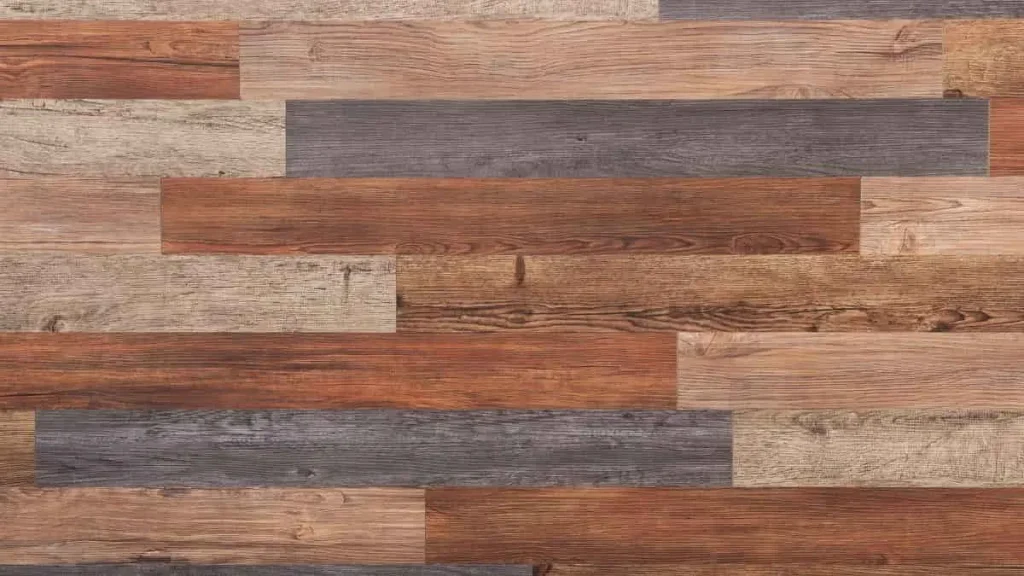
Why Is Hardwood Flooring Popular?
Hardwood is favored for its classic appearance and ability to enhance home value. It offers versatility in design, allowing homeowners to refinish it multiple times to change the color or repair any wear and tear. This adaptability makes it a long-lasting investment.
What Are the Advantages of Hardwood Flooring?
Hardwood flooring provides several benefits that make it a desirable choice for kitchens. First, it is incredibly durable when properly maintained. With regular care, it can last for decades. The ability to refinish hardwood also means that even after years of use, it can look like new again. Additionally, hardwood adds significant value to homes, which can be a great advantage if you’re considering resale in the future.
Another benefit is its versatility in terms of aesthetics. Hardwood comes in a variety of grains, finishes, and colors, making it adaptable to both traditional and modern kitchen designs.
What Are the Disadvantages of Hardwood Flooring?
Despite its many benefits, hardwood flooring is not without drawbacks. Kitchens are high-moisture areas, and hardwood is prone to water damage. Spills need to be wiped up quickly to prevent warping or staining. Humidity can also affect the wood, causing it to expand or contract, which may lead to gaps between the planks over time.
Another downside is the maintenance required. Hardwood needs regular cleaning and occasional refinishing to maintain its appearance. It can also scratch easily, especially in high-traffic areas or if heavy kitchen appliances are dragged across it.
How Much Does Hardwood Flooring Cost?
The cost of hardwood flooring can vary depending on the type of wood you choose. Solid hardwood is typically more expensive than engineered wood, but both can range from $8 to $15 per square foot, excluding installation costs. Installation fees can also be high, especially if you’re opting for a more intricate pattern.
Although the upfront cost is higher than some other materials, hardwood’s longevity and ability to increase home value make it a worthwhile investment for many homeowners.
How Do You Maintain Hardwood Flooring?
To maintain hardwood flooring, regular sweeping or vacuuming is essential to prevent dirt and debris from scratching the surface. It’s also a good idea to use rugs or mats in high-traffic areas, such as near the sink or stove, to protect the floor from moisture and wear.
When cleaning, avoid harsh chemicals. Instead, use a damp mop with a wood-safe cleaner. However, be careful not to over-wet the floor, as excess water can lead to damage. Refinishing the hardwood every few years will help it maintain its appearance and protect it from long-term wear.
What Style of Kitchen Suits Hardwood Flooring?
Hardwood flooring fits well in various kitchen styles, but it is especially popular in traditional and farmhouse kitchens. The natural wood grain adds warmth and character, which is ideal for creating a cozy, welcoming atmosphere. In modern or contemporary kitchens, hardwood can still be a good choice, especially if you opt for sleek, dark stains or wide planks to give a more updated look.
2. Tile Flooring (Ceramic and Porcelain)
Tile flooring, particularly ceramic and porcelain, is a durable and versatile option for kitchens. Made from natural materials like clay, sand, and water, these tiles are fired at high temperatures to create a hard surface that can withstand heavy foot traffic. Ceramic and porcelain tiles come in various styles, colors, and textures, making them a popular choice for homeowners who want both durability and aesthetic flexibility in their kitchen design.
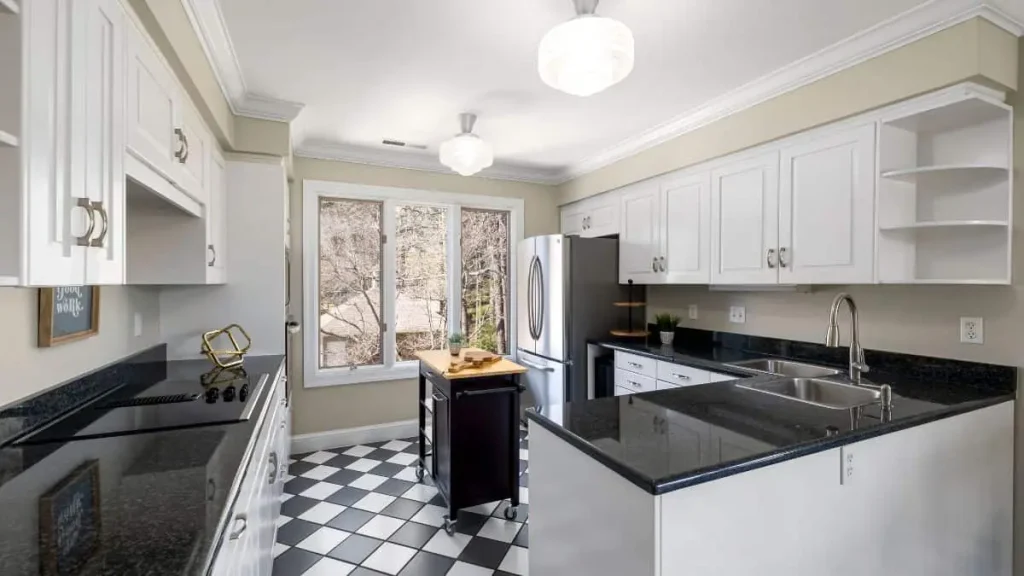
Why Is Tile Flooring Popular?
Tile flooring is widely appreciated for its resistance to water and stains, making it ideal for the high-moisture environment of a kitchen. Porcelain tiles, in particular, are denser and less porous than ceramic, offering greater durability and water resistance. Both types of tiles are available in a variety of finishes, including glossy, matte, and textured, giving homeowners the ability to customize their kitchen’s look.
Another reason for the popularity of tile is its compatibility with underfloor heating. Tiles are naturally cool to the touch, which can be a drawback in colder climates, but when combined with radiant heating systems, they provide warmth and comfort underfoot.
What Are the Advantages of Tile Flooring?
Tile flooring is incredibly durable, capable of withstanding daily wear and tear without showing much damage. Both ceramic and porcelain tiles are hard enough to resist scratches, making them a good option for busy kitchens with heavy foot traffic or where children and pets frequently roam. This durability extends to their lifespan, as tiles can last for decades with proper care.
One of the biggest advantages of tile flooring is its resistance to water, which is essential in a kitchen. Spills, splashes, and even leaks can be easily wiped up without damaging the floor. In addition, the non-porous surface of tiles makes them stain-resistant and hygienic, ideal for areas where food is prepared.
Tiles are also fire-resistant and environmentally friendly, especially if you choose tiles made from recycled materials.
What Are the Disadvantages of Tile Flooring?
While tile flooring offers many benefits, there are some downsides to consider. One significant drawback is that tiles can feel cold and hard underfoot, which may not be comfortable for long periods of standing. This can be mitigated with area rugs or underfloor heating, but it’s something to keep in mind, especially in cooler climates.
Tiles can also be slippery, particularly when wet, posing a potential safety hazard in the kitchen. Opting for textured or slip-resistant finishes can help reduce this risk, but it’s still a concern in high-traffic areas.
Another challenge with tile is the grout between the tiles. Grout lines can be difficult to clean and are prone to staining over time. Regular sealing is necessary to keep the grout looking fresh and to prevent it from absorbing moisture.
How Much Does Tile Flooring Cost?
The cost of tile flooring varies depending on whether you choose ceramic or porcelain tiles. Ceramic tiles are generally more affordable, ranging from $3 to $7 per square foot, while porcelain tiles are more expensive, typically costing between $5 and $10 per square foot. Installation costs also add to the expense, with labor fees varying depending on the complexity of the tile layout and whether any custom designs are incorporated.
Although the initial cost of tile flooring can be higher than other options like vinyl or laminate, its longevity and minimal maintenance requirements make it a cost-effective solution in the long run.
How Do You Maintain Tile Flooring?
Maintaining tile flooring is relatively straightforward. Regular sweeping or vacuuming will help keep dirt and debris off the surface, preventing scratches and maintaining the tile’s appearance. For deeper cleaning, a damp mop with a mild detergent is usually sufficient. Tiles are resistant to most stains, but it’s still a good idea to clean up spills quickly, particularly if the grout is exposed.
One area that requires extra attention is the grout between the tiles. Grout lines are prone to discoloration and can trap dirt, so it’s important to clean them regularly. Using a grout cleaner or a mixture of baking soda and water can help keep grout lines looking fresh. Additionally, sealing the grout every year or two will help prevent moisture and stains from penetrating it.
What Style of Kitchen Suits Tile Flooring?
Tile flooring works well in various kitchen styles due to its versatility in color, texture, and pattern. In Mediterranean and rustic kitchens, terracotta or hand-painted ceramic tiles add warmth and character. For modern or minimalist designs, large-format porcelain tiles in neutral colors like gray or white provide a sleek, clean look. In traditional kitchens, classic subway tiles or patterned ceramics can enhance the overall design, adding visual interest without overwhelming the space.
Porcelain tiles that mimic natural stone, wood, or cement are also a great choice for homeowners who want the appearance of these materials without the associated maintenance challenges. Whether your kitchen leans towards contemporary or classic design, tile flooring can easily be adapted to suit your style.
3. Vinyl Flooring (Luxury Vinyl Planks & Sheets)
Vinyl flooring, particularly luxury vinyl planks (LVP) and sheets, is a modern and affordable option for kitchen floors. Made from synthetic materials, vinyl is designed to mimic the look of natural surfaces like wood or stone while offering enhanced durability and water resistance. LVP refers to individual planks that resemble hardwood, while vinyl sheets come in larger, continuous rolls that can cover the entire floor without seams. Both options are popular for their versatility, ease of installation, and resistance to moisture, making them a practical choice for kitchens.

Why Is Vinyl Flooring Popular?
Vinyl flooring has gained popularity in recent years due to its ability to replicate high-end materials at a fraction of the cost. Luxury vinyl planks, for instance, closely mimic the appearance of hardwood or stone but are much more affordable and easier to maintain. Vinyl is also softer and warmer underfoot than harder materials like tile or stone, making it more comfortable for long periods of standing in the kitchen.
In addition, vinyl is highly water-resistant, which is essential in a kitchen where spills and moisture are common. Its durability, combined with easy maintenance, makes it a go-to option for busy households that need a flooring solution that looks great without requiring significant upkeep.
What Are the Advantages of Vinyl Flooring?
Vinyl flooring offers several practical benefits for kitchen use. One of its biggest advantages is water resistance. Vinyl is impervious to water, making it ideal for kitchens where spills, humidity, and cleaning are frequent. Unlike wood, vinyl won’t warp or swell when exposed to moisture, and it is also resistant to staining, making it easy to clean up after food preparation or accidents.
Another benefit of vinyl is its durability. Luxury vinyl planks and sheets are designed to withstand heavy foot traffic and can handle the daily wear and tear of a busy kitchen. Additionally, vinyl is softer underfoot than tile or stone, providing a more comfortable surface to stand on while cooking or cleaning.
The ease of installation is another advantage. Vinyl planks often come with a click-and-lock system, making them simple for DIY enthusiasts to install. Vinyl sheets are also relatively easy to lay down, as they can be cut to fit the size and shape of the room without requiring grout or special adhesives.
What Are the Disadvantages of Vinyl Flooring?
While vinyl flooring has many benefits, there are some downsides to consider. One potential drawback is that vinyl, while durable, is not as long-lasting as hardwood or tile. Over time, heavy furniture or appliances can leave dents in the surface, and sharp objects may cause cuts or tears. Vinyl is also prone to fading if exposed to direct sunlight for extended periods, which can affect the color and appearance over time.
Another disadvantage is that vinyl, especially lower-quality options, can have a synthetic look and feel. Although luxury vinyl planks can closely mimic natural materials, some homeowners may still prefer the authenticity of real wood or stone. Vinyl is also not biodegradable, which may be a concern for environmentally conscious homeowners.
How Much Does Vinyl Flooring Cost?
Vinyl flooring is one of the more affordable options for kitchen floors. Luxury vinyl planks typically range from $2 to $5 per square foot, while vinyl sheets are even more budget-friendly, often costing between $1 and $3 per square foot. Installation costs for vinyl are also lower compared to hardwood or tile, especially if you opt for a DIY installation.
The affordability of vinyl, combined with its durability and ease of maintenance, makes it an attractive option for homeowners looking to renovate their kitchen on a budget without sacrificing style.
How Do You Maintain Vinyl Flooring?
Maintaining vinyl flooring is simple and requires minimal effort. Regular sweeping or vacuuming will help keep dirt and debris off the surface, preventing scratches. For spills or messes, vinyl can be easily wiped clean with a damp mop and mild detergent. Unlike hardwood, there’s no need for waxing or refinishing, making vinyl a low-maintenance option.
Vinyl is also resistant to staining, so it’s easy to keep clean with just basic care. However, it’s important to avoid using harsh chemicals or abrasive cleaning tools, as they can damage the surface. To protect the floor, consider placing mats or rugs in high-traffic areas, such as near the sink or stove, to reduce wear.
What Style of Kitchen Suits Vinyl Flooring?
Vinyl flooring is versatile enough to fit a wide range of kitchen styles. Luxury vinyl planks can mimic the look of hardwood, making them a great choice for kitchens that aim for a warm, traditional feel. Whether you prefer oak, walnut, or a lighter wood grain, LVP can provide the aesthetic appeal of natural wood without the associated maintenance issues.
For modern kitchens, vinyl sheets or planks that imitate stone or concrete can create a sleek, minimalist look. Vinyl’s ability to replicate these materials without the cold, hard surface makes it a practical yet stylish option for contemporary designs. Additionally, vinyl comes in a variety of colors and patterns, allowing homeowners to experiment with bold or unique designs that might not be as feasible with natural materials.
4. Laminate Flooring
Laminate flooring is a synthetic flooring material designed to mimic the appearance of hardwood, stone, or tile. It consists of multiple layers, including a high-density fiberboard core and a photographic layer that replicates natural surfaces. The topmost layer is a clear protective coating that adds durability and scratch resistance. Laminate flooring is often chosen for kitchens because it offers the look of real wood or stone at a lower price point, with easier maintenance and installation. The interlocking design of laminate planks allows for a floating installation, which means it can be laid over existing floors without the need for adhesives.

Why Is Laminate Flooring a Popular Choice for Kitchens?
Laminate flooring has gained popularity in kitchens due to its affordability and its ability to closely replicate the appearance of more expensive materials, such as hardwood or tile. Homeowners who want the look of natural wood but are concerned about the cost or maintenance issues associated with it often turn to laminate as a budget-friendly alternative. Additionally, laminate is more resistant to stains and scratches compared to real wood, making it a practical choice for busy kitchens where spills and foot traffic are frequent.
Another reason laminate is favored for kitchens is its versatility in design. Whether homeowners prefer the look of rustic oak, sleek walnut, or even stone tiles, laminate offers a wide range of design options that can fit various kitchen styles. The ability to achieve these looks without the higher price tag of real materials makes laminate an appealing choice for those renovating on a budget.
What Are the Advantages of Laminate Flooring?
One of the key advantages of laminate flooring in kitchens is its durability. The top protective layer is designed to resist scratches, making it ideal for areas that see a lot of activity, such as kitchens. It’s also highly resistant to stains and easy to clean, which is a major advantage in a kitchen where food spills are common. Laminate doesn’t absorb liquids as easily as wood, and most spills can be wiped up quickly without leaving permanent marks.
Another significant advantage is the ease of installation. Laminate planks are designed to interlock, allowing for a floating installation that doesn’t require nails, glue, or grout. This makes laminate a great option for DIY homeowners looking to cut down on installation costs. It can also be installed over most existing flooring, which can simplify the renovation process.
Lastly, laminate offers a wide range of aesthetic choices. Whether you prefer a traditional kitchen with the warmth of wood or a modern kitchen with the sleek appearance of stone, laminate can provide a variety of designs to match your style. The photographic layer of laminate flooring is high-quality, creating a realistic look that can mimic expensive materials without the associated cost.
What Are the Disadvantages of Laminate Flooring?
While laminate flooring has many benefits, it does come with some limitations, especially in kitchen environments. One of the primary drawbacks is its susceptibility to water damage. Although the surface is water-resistant, laminate is not waterproof. Excessive moisture or prolonged exposure to water can cause the planks to swell, warp, or separate. In kitchens where spills or leaks are frequent, this can be a significant concern.
Another disadvantage is the fact that laminate cannot be refinished. Unlike hardwood, which can be sanded and refinished multiple times over its lifetime, laminate flooring has a fixed lifespan. Once the top protective layer is worn or damaged, the entire plank will need to be replaced. This makes laminate less durable in the long term compared to hardwood or tile, which can last for decades with proper care.
Additionally, laminate may not have the same feel or sound as natural wood. Some homeowners find that laminate lacks the warmth or authenticity of real hardwood, particularly when it comes to the texture underfoot. The hollow sound produced by walking on laminate can also be a drawback, although this can be mitigated by using an underlayment.
How Much Does Laminate Flooring Cost?
Laminate flooring is generally more affordable than hardwood or tile, making it a popular choice for budget-conscious kitchen renovations. On average, laminate planks cost between $1 and $4 per square foot, depending on the quality and design. Installation costs are also lower than hardwood or tile, especially if you choose to install it yourself. However, professional installation typically ranges from $2 to $5 per square foot, bringing the total cost to between $3 and $9 per square foot, including materials and labor.
For homeowners looking to achieve the look of natural wood or stone without the high cost, laminate is a cost-effective solution. It allows you to transform the appearance of your kitchen without sacrificing style, and its durability means you won’t need to replace it as frequently as cheaper flooring options like vinyl or linoleum.
How Do You Maintain Laminate Flooring?
Maintaining laminate flooring is relatively straightforward. Regular sweeping or vacuuming is recommended to remove dirt and debris that can cause scratches on the surface. For cleaning, a damp mop with a mild cleaner specifically designed for laminate floors is typically sufficient. However, it’s important to avoid using excessive water when cleaning laminate, as too much moisture can seep into the seams and cause damage over time.
Unlike hardwood, laminate does not require waxing or polishing. In fact, applying wax or polish to laminate flooring can damage the protective layer. For tougher stains or marks, it’s best to use a gentle cleaner and a soft cloth rather than abrasive tools or chemicals that can scratch or erode the surface.
It’s also advisable to use felt pads under furniture to prevent scratching, and to place mats or rugs in high-traffic areas, such as near the sink or stove, to protect the flooring from wear and tear.
What Style of Kitchen Suits Laminate Flooring?
Laminate flooring is versatile and can suit a wide range of kitchen styles, from traditional to contemporary. In kitchens that aim for a rustic or farmhouse aesthetic, laminate planks that mimic distressed wood or hand-scraped finishes can create a cozy and inviting atmosphere. The wide variety of wood-look options makes it easy to match the flooring with cabinetry, countertops, and other design elements.
For more modern kitchens, laminate that resembles sleek, polished hardwood or even stone can complement minimalist or industrial designs. The smooth surface and uniform appearance of laminate work well with clean lines and modern materials like stainless steel and glass. Additionally, laminate’s resistance to scratches and stains makes it a practical choice for busy households where aesthetics and functionality are equally important.
5. Natural Stone Flooring
Natural stone flooring refers to flooring materials sourced directly from the earth, including options like slate, marble, and travertine. Each type of stone offers unique aesthetics and characteristics, contributing to the overall beauty and appeal of a kitchen. Natural stone is prized for its durability and timeless elegance, making it a popular choice for homeowners seeking to create a sophisticated atmosphere.
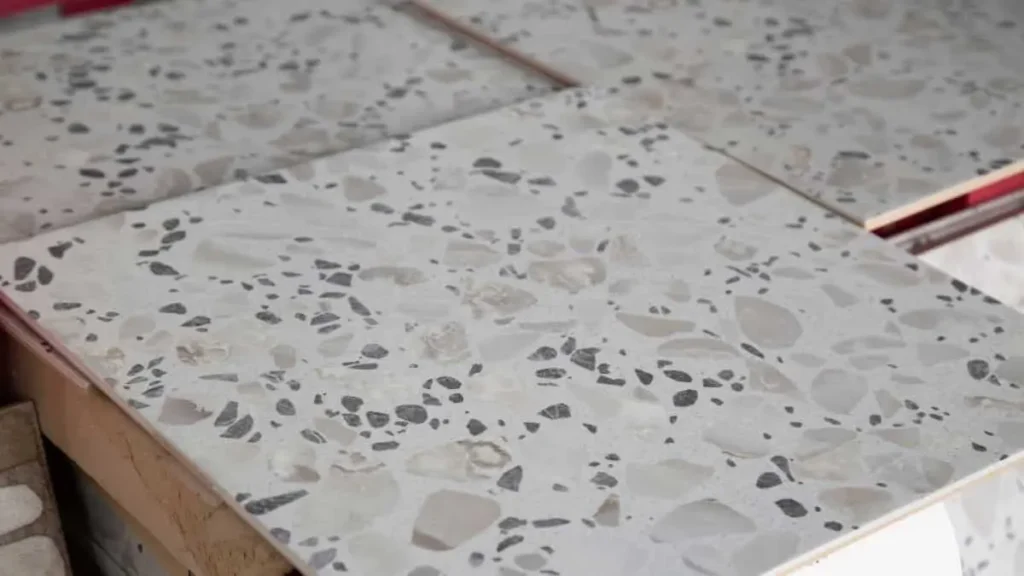
Why Is Natural Stone Flooring a Popular Choice for Kitchens?
Natural stone flooring has become a favored option in kitchens due to its luxurious look and remarkable durability. The natural variations in color and pattern found in stones like marble and travertine add character and uniqueness to each installation, making every kitchen floor one-of-a-kind. This individuality appeals to many homeowners who want to create a personalized space.
In addition to aesthetic appeal, natural stone is incredibly durable and can withstand heavy foot traffic, making it ideal for the often-busy environment of a kitchen. Stone floors are also heat-resistant, which means they can tolerate spills from hot pots and pans without sustaining damage. This feature is particularly beneficial in kitchen settings, where temperature fluctuations can be common.
Moreover, natural stone has a timeless quality that complements a variety of design styles, from rustic to contemporary. It can serve as a stunning backdrop for various kitchen elements, allowing homeowners to express their style while enjoying the practicality of stone flooring.
What Are the Advantages of Natural Stone Flooring?
One of the primary advantages of natural stone flooring is its unparalleled durability. Stone can resist scratches, dents, and wear, making it an excellent choice for high-traffic areas. Additionally, natural stone is not susceptible to damage from water or heat, which are common concerns in kitchen environments. This resilience contributes to the long lifespan of stone flooring, allowing homeowners to enjoy its beauty for years to come.
Natural stone is also naturally cool to the touch, which can be advantageous in warmer climates. It helps regulate temperature, making kitchens more comfortable during hot weather. When combined with underfloor heating, stone flooring can create a cozy atmosphere during colder months, enhancing the overall comfort of the kitchen.
Furthermore, natural stone is easy to clean and maintain. Regular sweeping and mopping with a pH-neutral cleaner can keep the surface looking fresh. Unlike some synthetic materials, natural stone does not harbor allergens or bacteria, making it a hygienic option for kitchen flooring.
What Are the Disadvantages of Natural Stone Flooring?
Despite its many benefits, natural stone flooring does have some drawbacks. One notable concern is the porosity of certain types of stone, such as travertine and marble. These stones can absorb liquids, which may lead to staining if spills are not addressed promptly. To mitigate this risk, it is crucial to seal natural stone flooring regularly to protect it from moisture and stains.
Another disadvantage is the weight of natural stone. Depending on the specific type of stone chosen, the flooring can be quite heavy, which may require additional structural support in the home. This can complicate installation and may lead to increased costs.
Additionally, natural stone can be more expensive than other flooring options, such as laminate or vinyl. The initial investment may be significant, and installation costs can also be higher due to the need for professional handling and cutting of the stone.
How Much Does Natural Stone Flooring Cost?
The cost of natural stone flooring varies significantly depending on the type of stone chosen. On average, homeowners can expect to pay between $5 and $15 per square foot for materials. Slate is generally at the lower end of this spectrum, while marble tends to be on the higher end due to its luxurious appeal and rarity.
In addition to material costs, professional installation can range from $4 to $10 per square foot, making the total cost of natural stone flooring between $9 and $25 per square foot, including both materials and labor. While the upfront investment may be higher than for other flooring options, the durability and timeless beauty of natural stone can provide long-term value.
How Do You Maintain Natural Stone Flooring?
Maintaining natural stone flooring involves several key practices to ensure its longevity and appearance. Regular sweeping or vacuuming is essential to remove dirt and debris that can scratch the surface. For cleaning, a damp mop with a pH-neutral cleaner is recommended to avoid damaging the stone. It is crucial to avoid acidic or harsh chemical cleaners, as these can erode the stone’s surface.
Sealing the stone is also vital to protect it from stains and moisture. The frequency of sealing will depend on the type of stone and its usage, but generally, it is recommended to seal natural stone every 6 to 12 months. Homeowners should conduct a simple water test to check if the stone is absorbing liquids; if water beads on the surface, the seal is effective.
If spills occur, they should be wiped up immediately to prevent staining. For tougher stains, specific stain removers designed for natural stone may be necessary, but care should be taken to follow the manufacturer’s guidelines to avoid damaging the stone.
What Style of Kitchen Suits Natural Stone Flooring?
Natural stone flooring can complement a variety of kitchen styles, enhancing the overall aesthetic. In traditional kitchens, the rich tones of slate or the intricate veining of marble can add elegance and warmth. Rustic designs benefit from the textured surface of travertine or slate, which can create a cozy, inviting atmosphere.
In modern kitchens, the sleek look of polished marble or the earthy appeal of natural slate can provide a stunning contrast to contemporary cabinetry and appliances. The natural variations in stone can also serve as a focal point in minimalist designs, making the flooring an essential part of the overall decor.
Ultimately, natural stone flooring’s versatility and timeless appeal make it a suitable choice for various kitchen styles, allowing homeowners to create a space that reflects their personal taste and enhances the overall design.
6. Cork Flooring
Cork flooring is a sustainable flooring option made from the bark of cork oak trees. This unique material is harvested without harming the tree, allowing it to regenerate over time. Cork flooring is gaining popularity in kitchens due to its eco-friendly properties and distinct aesthetic. It offers a warm, natural look that can complement various kitchen styles, making it an appealing choice for environmentally conscious homeowners.
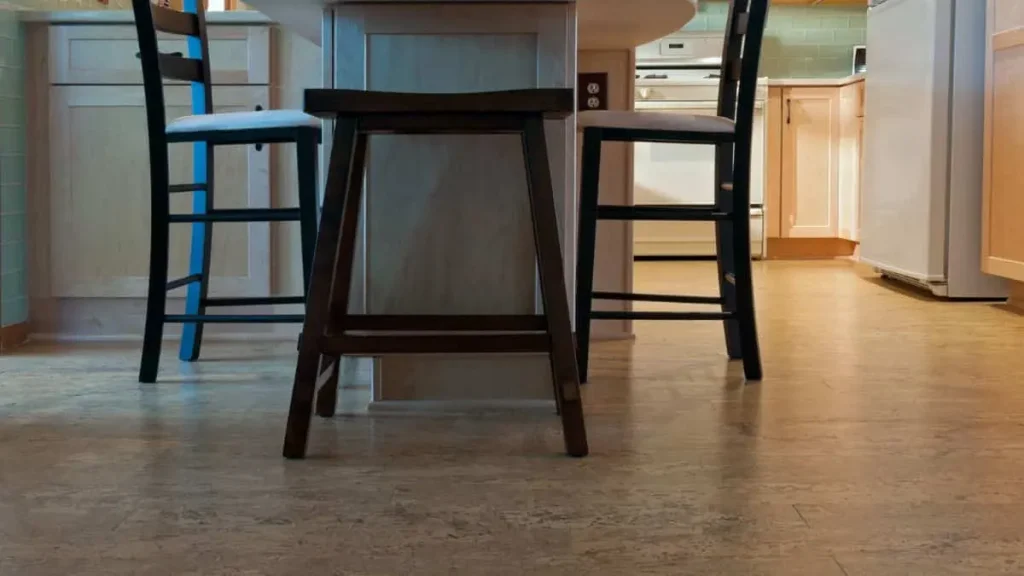
Why Is Cork Flooring a Popular Choice for Kitchens?
Cork flooring has become a favored option in kitchens primarily due to its sustainability and comfort. The soft, cushioned surface of cork provides a comfortable feel underfoot, making it pleasant to stand on for extended periods. This feature is particularly beneficial in kitchens, where individuals often spend a significant amount of time cooking and preparing meals.
Additionally, cork is a natural insulator, helping to maintain a comfortable temperature in the kitchen. Its ability to absorb sound makes it an ideal choice for busy households, reducing noise levels and creating a more peaceful environment. This acoustic benefit is particularly appealing in open-concept kitchens, where sounds from the kitchen can easily carry into adjacent living spaces.
Cork is also resistant to mold, mildew, and pests, which contributes to a healthier indoor environment. This characteristic is crucial in kitchens, where moisture levels can fluctuate. The natural antimicrobial properties of cork make it a hygienic option, ensuring that kitchens remain clean and safe for food preparation.
What Are the Advantages of Cork Flooring?
One of the significant advantages of cork flooring is its sustainability. As a renewable resource, cork flooring has a lower environmental impact compared to many traditional flooring options. Homeowners can feel good about choosing a product that supports sustainable forestry practices.
Cork flooring is also known for its excellent insulation properties. It can help regulate indoor temperatures, contributing to energy efficiency. This characteristic can lead to lower energy bills, as the need for heating and cooling systems may be reduced.
Another notable benefit is cork’s shock-absorbing qualities. The cushioning effect of cork reduces strain on joints and feet, making it a comfortable choice for individuals who spend long hours in the kitchen. This feature also minimizes the risk of injuries from slips and falls.
What Are the Disadvantages of Cork Flooring?
Despite its many benefits, cork flooring does have some drawbacks. One significant concern is its vulnerability to damage from sharp objects or heavy furniture. Although cork is resilient, it can dent or scratch under pressure, which may necessitate extra care when moving furniture or handling kitchen equipment.
Additionally, cork flooring may fade when exposed to direct sunlight over time. Homeowners should consider this factor when choosing cork flooring for their kitchens, as prolonged sunlight exposure can alter the appearance of the flooring.
Another drawback is that cork can absorb liquids if not sealed properly. While cork is naturally resistant to moisture, spills should be wiped up promptly to prevent potential water damage. Regular sealing can help protect cork flooring from moisture but requires ongoing maintenance.
How Much Does Cork Flooring Cost?
The cost of cork flooring typically ranges from $3 to $8 per square foot for materials, making it a moderately priced option. Installation costs can vary but generally range from $2 to $5 per square foot. As a result, homeowners can expect to pay between $5 and $13 per square foot for cork flooring, including both materials and labor.
Although cork may be slightly more expensive than some laminate or vinyl options, its sustainability and comfort can provide long-term value. The unique qualities of cork flooring can contribute to a cozy and inviting kitchen environment.
How Do You Maintain Cork Flooring?
Maintaining cork flooring is relatively straightforward. Regular sweeping or vacuuming is essential to remove dirt and debris that can scratch the surface. For deeper cleaning, a damp mop with a pH-neutral cleaner is recommended. Homeowners should avoid using excessive water, as cork can absorb moisture, leading to potential damage.
To preserve its appearance, cork flooring should be sealed every few years, depending on usage and wear. This sealing process helps protect the cork from moisture and stains, ensuring its longevity. If spills occur, they should be addressed immediately to prevent absorption.
What Style of Kitchen Suits Cork Flooring?
Cork flooring can enhance various kitchen styles, particularly those that emphasize natural elements. It complements rustic and farmhouse designs, providing a warm, inviting look. The earthy tones and textures of cork can also harmonize with contemporary and modern kitchens, creating a seamless connection between indoor and outdoor spaces.
In eco-friendly or sustainable kitchens, cork flooring is an ideal choice, reinforcing the commitment to environmentally responsible practices. Its versatility allows it to fit well with different cabinetry, countertops, and appliance styles, making it a flexible option for homeowners.
7. Bamboo Flooring
Bamboo flooring is an eco-friendly flooring option made from the fast-growing bamboo plant. Although technically a grass, bamboo possesses similar qualities to hardwood, making it a popular choice for homeowners seeking a sustainable and stylish alternative. Bamboo flooring is not only visually appealing but also durable, providing a unique aesthetic that can elevate any kitchen design.
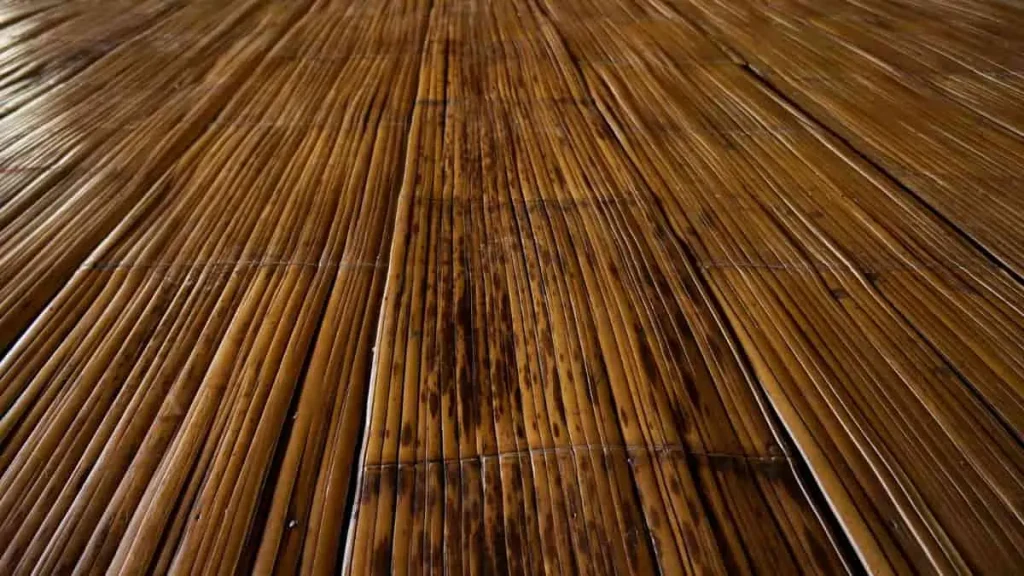
Why Is Bamboo Flooring a Popular Choice for Kitchens?
Bamboo flooring has gained popularity in kitchens due to its sustainable nature and resilience. As one of the fastest-growing plants in the world, bamboo is harvested without causing deforestation, making it an environmentally friendly choice. Homeowners increasingly seek materials that minimize environmental impact, and bamboo fits this criterion well.
In addition to sustainability, bamboo is remarkably durable. It has a hardness rating comparable to traditional hardwoods, making it suitable for high-traffic areas like kitchens. This durability helps bamboo withstand the demands of daily use, including spills and heavy foot traffic.
Another appealing aspect of bamboo flooring is its natural beauty. The unique grain patterns and colors of bamboo can create a visually stunning backdrop for various kitchen styles. Whether in a modern or traditional kitchen, bamboo’s aesthetic versatility can enhance the overall design.
What Are the Advantages of Bamboo Flooring?
One significant advantage of bamboo flooring is its sustainability. As a rapidly renewable resource, bamboo grows much faster than traditional hardwood trees, allowing for quicker harvesting without depleting forests. This characteristic aligns with the growing trend toward eco-conscious home renovations.
Bamboo flooring is also known for its resilience. It can withstand heavy use without significant wear, making it ideal for kitchens where foot traffic and spills are common. Its natural resistance to moisture helps prevent warping and damage from spills, contributing to its suitability in kitchen environments.
Furthermore, bamboo flooring is relatively easy to maintain. Regular sweeping and occasional damp mopping can keep it looking fresh and clean. Unlike some flooring options, bamboo does not require extensive maintenance or special cleaning products, making it a convenient choice for busy homeowners.
What Are the Disadvantages of Bamboo Flooring?
Despite its many benefits, bamboo flooring has some drawbacks. One concern is its susceptibility to scratches and dents. While bamboo is durable, it can be prone to damage from sharp objects or heavy furniture. Homeowners should take care when moving items across the floor to minimize the risk of scratches.
Another potential disadvantage is bamboo’s vulnerability to moisture. Although bamboo is naturally resistant to water, prolonged exposure to humidity or spills can lead to warping or swelling. Homeowners should promptly clean up spills and avoid excessive water during cleaning to maintain the flooring’s integrity.
Additionally, bamboo can be more susceptible to fading from sunlight compared to some traditional hardwoods. Homeowners should consider using window treatments or rugs to protect the flooring from direct sunlight exposure, preserving its appearance over time.
How Much Does Bamboo Flooring Cost?
The cost of bamboo flooring typically ranges from $3 to $8 per square foot for materials, making it a competitive option compared to hardwood flooring. Installation costs can vary but generally range from $2 to $5 per square foot. Homeowners can expect to pay between $5 and $13 per square foot for bamboo flooring, including both materials and labor.
The moderate cost, combined with its sustainability and aesthetic appeal, makes bamboo flooring an attractive choice for homeowners looking to enhance their kitchens without breaking the bank.
How Do You Maintain Bamboo Flooring?
Maintaining bamboo flooring is relatively simple. Regular sweeping or vacuuming is essential to remove dirt and debris that can scratch the surface. For cleaning, a damp mop with a pH-neutral cleaner is recommended to avoid damaging the finish. Homeowners should refrain from using excessive water or harsh chemicals, as these can affect the integrity of the bamboo.
To protect bamboo flooring from scratches, homeowners should consider using furniture pads under heavy items. Regularly checking for any signs of wear or damage can help address issues before they become significant problems.
Bamboo flooring also benefits from periodic refinishing to maintain its appearance. Depending on usage, refinishing may be necessary every 5 to 10 years. This process can restore the original beauty of the flooring and extend its lifespan.
What Style of Kitchen Suits Bamboo Flooring?
Bamboo flooring can complement a variety of kitchen styles, particularly those that prioritize natural materials and eco-friendly design. Its warm tones and unique grain patterns enhance modern, minimalist, and contemporary kitchens, creating a fresh and inviting atmosphere.
In eco-conscious or sustainable kitchens, bamboo flooring aligns perfectly with the design ethos, reinforcing a commitment to environmentally friendly practices. Its versatility allows it to harmonize with various cabinetry and countertop materials, making it a flexible choice for diverse kitchen aesthetics.
Maintenance Tips for Longevity
Taking care of your kitchen flooring is essential to ensuring its longevity and maintaining its aesthetic appeal. Each flooring type has specific needs, and understanding these requirements can help homeowners prolong the life of their investment. By adopting effective maintenance practices, you can keep your kitchen floor looking pristine for years to come.
General Maintenance Tips for All Flooring Types
Regardless of the type of flooring you choose, some fundamental maintenance practices apply to all. Regular cleaning is crucial; sweeping or vacuuming daily can help remove dirt and debris that may scratch or damage the floor’s surface. Homeowners should also establish a routine for damp mopping, using appropriate cleaning solutions for their specific flooring type. It’s essential to avoid harsh chemicals and abrasive tools, as these can wear down the finish and damage the material over time.
Another critical aspect of maintenance is managing moisture. Kitchens are prone to spills and humidity, which can adversely affect various flooring types. Promptly cleaning up spills and using area rugs in high-traffic zones can protect your flooring from moisture-related issues. Additionally, maintaining proper ventilation in the kitchen helps reduce humidity levels, which is especially important for wood, bamboo, and cork flooring.
Specific Tips for Different Flooring Types
Hardwood Flooring
To keep hardwood floors in top condition, it’s vital to maintain their finish. Homeowners should consider refinishing hardwood floors every 5 to 10 years, depending on wear and tear. Regularly checking for scratches and dents is essential, as addressing minor issues early can prevent more significant damage. Using furniture pads and avoiding high heels or shoes with hard soles can help protect the surface.
Additionally, homeowners should consider applying a protective sealant to hardwood floors. This sealant can help guard against moisture and stains, enhancing the floor’s durability. When cleaning, it’s best to use a microfiber mop and a pH-balanced wood cleaner to avoid damaging the finish.
Tile Flooring (Ceramic and Porcelain)
Tile floors are generally low maintenance, but keeping the grout lines clean can be a challenge. Regularly sweeping and mopping tile floors is essential, and using a grout cleaner occasionally will help maintain the appearance of both the tiles and grout. Sealing the grout every year or two is recommended to prevent stains and moisture buildup, which can lead to mold growth.
For areas with heavy foot traffic, homeowners might consider using a tile-specific cleaner that can provide additional protection and shine. Avoiding harsh chemicals is important, as they can dull the surface of the tiles over time.
Vinyl Flooring (Luxury Vinyl Planks & Sheets)
Vinyl flooring is known for its durability, but it still requires care to maintain its appearance. Homeowners should regularly sweep and mop vinyl floors with a gentle, pH-neutral cleaner to avoid leaving residues that can cause fading or discoloration. While vinyl is resistant to water, it’s still important to dry any spills promptly to prevent slipping hazards and protect the adhesive underneath.
To prevent scratches and dents, using furniture pads is advisable, especially for heavy items. Homeowners should avoid using steam cleaners, as the heat can damage the vinyl’s surface.
Laminate Flooring
Laminate flooring is designed to be durable but can be susceptible to moisture damage if not maintained properly. Regular sweeping and dry mopping are essential to remove dirt and prevent scratching. When mopping, it’s crucial to use a slightly damp mop with a laminate-safe cleaner, avoiding excessive moisture.
Homeowners should also keep an eye out for any signs of wear, such as fading or peeling. If necessary, applying a protective coating can help extend the life of laminate flooring. To prevent scratches, placing area rugs in high-traffic zones and using furniture pads under heavy items is recommended.
Natural Stone Flooring (Slate, Marble, Travertine)
Natural stone floors require specific care to maintain their beauty and integrity. Regular sweeping or dust mopping is essential to avoid scratching the surface. For deeper cleaning, a pH-neutral stone cleaner should be used, and it’s crucial to avoid acidic or abrasive cleaners that can damage the stone.
Sealing natural stone is necessary to protect against stains and moisture infiltration. Depending on the type of stone and the level of foot traffic, sealing should be done every 6 to 12 months. Homeowners should also be cautious with heavy furniture, as the weight can cause cracking or chipping.
Cork Flooring
Cork flooring is relatively low maintenance but requires some specific care. Regular sweeping or vacuuming helps prevent dirt and debris buildup, while damp mopping with a pH-neutral cleaner keeps it looking fresh. Homeowners should avoid soaking the cork during cleaning, as excessive moisture can lead to warping.
To maintain its natural beauty, cork flooring should be sealed every few years, which protects it from stains and moisture. Taking care to use pads under furniture can also help prevent dents and scratches.
Bamboo Flooring
Maintaining bamboo flooring involves regular cleaning to prevent dirt accumulation. Homeowners should sweep or vacuum frequently and use a damp mop with a bamboo-friendly cleaner to keep the surface clean. As with other wood products, it’s important to avoid excessive moisture and harsh cleaning products.
Refinishing bamboo flooring every few years can help restore its original appearance and protect against wear. Homeowners should also be mindful of scratches, placing area rugs in high-traffic areas and using furniture pads to minimize damage.
Style and Aesthetic Considerations
Selecting the right flooring for your kitchen goes beyond functionality; it significantly impacts the overall design and ambiance of the space. Aesthetic considerations should align with your personal style and the kitchen’s existing decor. This section explores how different flooring materials contribute to various design aesthetics, ensuring that your kitchen remains visually appealing and cohesive.
Choosing a Style That Complements Your Kitchen Design
When selecting flooring, consider the overall theme of your kitchen. For a modern kitchen, sleek materials like polished concrete or large-format tiles can enhance a contemporary look. In contrast, traditional kitchens often benefit from the warmth of hardwood or classic ceramic tiles. For those who embrace a rustic aesthetic, natural stone or reclaimed wood can bring a charming, earthy feel.
It’s essential to think about the color palette as well. Lighter flooring options can create an airy and open atmosphere, making the kitchen feel more spacious. Darker floors can add depth and sophistication but may require careful consideration of lighting to prevent the space from feeling closed in. Additionally, choosing a flooring material that harmonizes with cabinetry, countertops, and wall colors is crucial for achieving a cohesive design.
Texture and Pattern Considerations
The texture and pattern of your flooring can also play a significant role in your kitchen’s aesthetic. Textured surfaces can add interest and depth, while smooth finishes create a sleek and polished look. For example, hand-scraped hardwood or textured tiles can introduce an inviting, tactile element to the space, appealing to those who enjoy a more organic feel.
Patterns can also enhance visual interest. For instance, geometric tiles can create a striking focal point, while classic herringbone or checkerboard patterns evoke a sense of tradition. When incorporating patterns, it’s important to strike a balance; overly busy designs can overwhelm the space, while subtle patterns can enhance the overall aesthetic without dominating it.
Integrating Flooring with Other Design Elements
Integrating flooring with other design elements, such as lighting, cabinetry, and fixtures, ensures a harmonious look throughout the kitchen. For instance, pairing light flooring with dark cabinetry creates a striking contrast that can elevate the design. Similarly, selecting flooring that complements the countertop material can create a unified appearance.
Lighting also plays a critical role in showcasing your flooring choice. Natural light can enhance the color and texture of the flooring, while artificial lighting can help define the space. Installing under-cabinet lighting can illuminate your flooring beautifully, highlighting its unique features and adding warmth to the kitchen.
Conclusion
In conclusion, selecting the right kitchen flooring involves careful consideration of various factors, including material properties, aesthetics, and maintenance needs. Each flooring type offers distinct advantages and design possibilities, catering to different preferences and lifestyles.
Whether you prefer the timeless elegance of hardwood, the durability of vinyl, or the rustic charm of natural stone, understanding the nuances of each option will help you make an informed choice.



